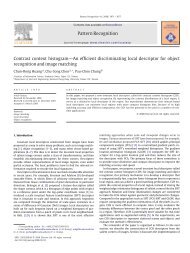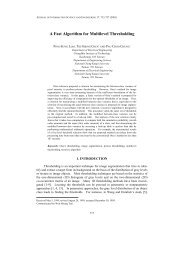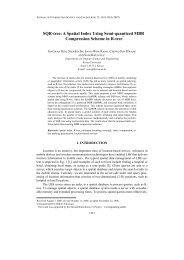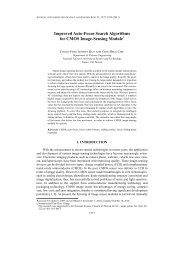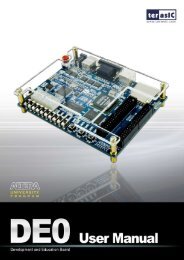Design, Implementation, and Performance Evaluation of Flash ...
Design, Implementation, and Performance Evaluation of Flash ...
Design, Implementation, and Performance Evaluation of Flash ...
You also want an ePaper? Increase the reach of your titles
YUMPU automatically turns print PDFs into web optimized ePapers that Google loves.
FLASH MEMORY-BASED FILE SYSTEM ON CHIP<br />
the computation on the currently read data is complete, <strong>and</strong> reads are non-blocking<br />
<strong>and</strong>/or, without loss <strong>of</strong> generality, assume that two processes cooperate per application,<br />
one for I/O processing <strong>and</strong> one for computation. We also assume that data read requests<br />
are issued as soon as the bus <strong>and</strong> storage become available, that is, the highest priority is<br />
given to I/O processing <strong>and</strong> when I/O processing is available the operating system notifies<br />
the process so it can suspend computation, issue I/O request, <strong>and</strong> resume computation.<br />
Similarly to the performance model presented for serial execution <strong>of</strong> I/O <strong>and</strong> computation,<br />
the application execution time for a conventional storage device can be derived<br />
from operations <strong>of</strong> the host CPU, bus, <strong>and</strong> storage device. Fig. 5 depicts the execution<br />
behavior when I/O <strong>and</strong> computation may be overlapped. The application execution time<br />
for this case is given in Eq. (3). Similarly, the execution behavior for FSOC is depicted in<br />
Fig. 6, <strong>and</strong> the application execution time is given in Eq. (4). Note that if N is 1, then Eqs.<br />
(3) <strong>and</strong> (4) <strong>and</strong> Eqs. (1) <strong>and</strong> (2), respectively, become the same. Both situations represent<br />
the case where I/O processing <strong>and</strong> computation cannot overlap.<br />
CPU<br />
Bus<br />
Storage<br />
initialization<br />
read request<br />
for data unit 1<br />
C F D<br />
M<br />
read request<br />
for data unit 2<br />
T<br />
process<br />
data unit 1<br />
F D C F D C<br />
C C<br />
C<br />
M<br />
read request<br />
for data unit 3<br />
T<br />
M<br />
T<br />
process<br />
data unit 2<br />
C: application code execution<br />
D: device driver code execution<br />
F: file system code execution<br />
M: media access<br />
T: data transfer<br />
process<br />
data unit 3<br />
output<br />
result<br />
Fig. 5. Operations <strong>of</strong> host CPU, bus, <strong>and</strong> storage device for conventional storage device when I/O<br />
<strong>and</strong> computation are executed in parallel (N = 3, T comp_serial = 2 time units, T comp = 3 time<br />
units, <strong>and</strong> all other parameters are <strong>of</strong> 1 time unit).<br />
CPU<br />
Bus<br />
Storage<br />
initialization<br />
read request<br />
for data unit 1<br />
C<br />
S<br />
F<br />
M<br />
read request<br />
for data unit 2<br />
T<br />
S C<br />
S<br />
F<br />
process<br />
data unit 1<br />
M<br />
read request<br />
for data unit 3<br />
T<br />
F<br />
process<br />
data unit 2<br />
C C<br />
C<br />
M<br />
T<br />
C: application code execution<br />
S: stub code execution<br />
F: file system code execution<br />
M: media access<br />
T: data transfer<br />
process<br />
data unit 3<br />
output<br />
result<br />
Fig. 6. Operations <strong>of</strong> host CPU, bus, <strong>and</strong> storage device for FSOC when I/O <strong>and</strong> computation are<br />
executed in parallel (N = 3, T comp_serial = 2 time units, T comp = 3 time units, <strong>and</strong> all other parameters<br />
are <strong>of</strong> 1 time unit).<br />
1873<br />
Time<br />
Time





